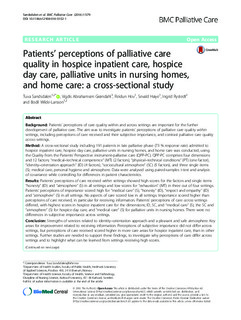Patients' perceptions of palliative care quality in hospice inpatient care, hospice day care, palliative units in nursing homes and home care: a cross-sectional study
Sandsdalen, Tuva; Grøndahl, Vigdis Abrahamsen; Hov, Reidun; Høye, Sevald; Rystedt, Ingrid; Larsson, Bodil Wilde
Journal article, Peer reviewed
Published version
Permanent lenke
http://hdl.handle.net/11250/2494575Utgivelsesdato
2016Metadata
Vis full innførselSamlinger
Sammendrag
Background: Patients’ perceptions of care quality within and across settings are important for the further development of palliative care. The aim was to investigate patients’ perceptions of palliative care quality within settings, including perceptions of care received and their subjective importance, and contrast palliative care quality across settings. Method: A cross-sectional study including 191 patients in late palliative phase (73 % response rate) admitted to hospice inpatient care, hospice day care, palliative units in nursing homes, and home care was conducted, using the Quality from the Patients’ Perspective instrument-palliative care (QPP-PC). QPP-PC comprises four dimensions and 12 factors; “medical–technical competence” (MT) (2 factors), “physical–technical conditions” (PT) (one factor), “identity–orientation approach” (ID) (4 factors), “sociocultural atmosphere” (SC) (5 factors), and three single items (S); medical care, personal hygiene and atmosphere. Data were analysed using paired-samples t-test and analysis of covariance while controlling for differences in patient characteristics. Results: Patients’ perceptions of care received within settings showed high scores for the factors and single items “honesty” (ID) and “atmosphere” (S) in all settings and low scores for “exhaustion” (MT) in three out of four settings. Patients’ perceptions of importance scored high for “medical care” (S), “honesty” (ID), “respect and empathy” (ID) and “atmosphere” (S) in all settings. No aspects of care scored low in all settings. Importance scored higher than perceptions of care received, in particular for receiving information. Patients’ perceptions of care across settings differed, with highest scores in hospice inpatient care for the dimensions; ID, SC, and “medical care” (S), the SC and “atmosphere” (S) for hospice day care, and “medical care” (S) for palliative units in nursing homes. There were no differences in subjective importance across settings. Conclusion: Strengths of services related to identity–orientation approach and a pleasant and safe atmosphere. Key areas for improvement related to receiving information. Perceptions of subjective importance did not differ across settings, but perceptions of care received scored higher in more care areas for hospice inpatient care, than in other settings. Further studies are needed to support these findings, to investigate why perceptions of care differ across settings and to highlight what can be learned from settings receiving high scores.
